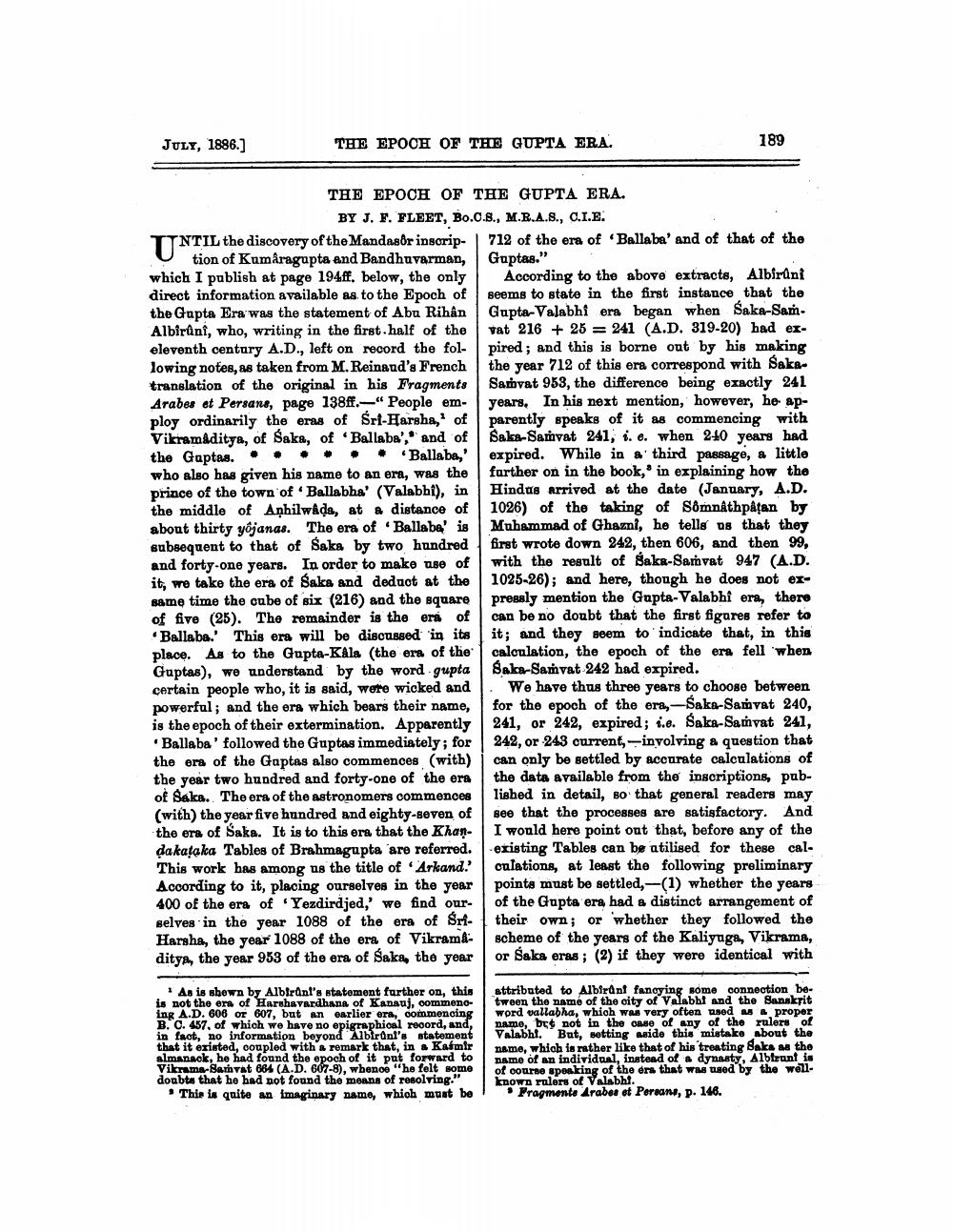________________
JULY, 1886.]
THE EPOCH OF THE GUPTA ERA.
THE EPOCH OF THE GUPTA ERA. BY J. F. FLEET, Bo.C.S., M.B.A.S., C.I.E.
UN
NTIL the discovery of the Mandasôr inscription of Kumaragupta and Bandhuvarman, which I publish at page 194ff. below, the only direct information available as to the Epoch of the Gupta Era was the statement of Abu Rihân Albirûnî, who, writing in the first half of the eleventh century A.D., left on record the following notes, as taken from M. Reinand's French translation of the original in his Fragments Arabes et Persans, page 138ff.-" People employ ordinarily the eras of Sri-Harsha,' of Vikramaditya, of Saka, of Ballaba', and of the Guptas. 'Ballaba,' who also has given his name to an era, was the prince of the town of Ballabha' (Valabhi), in the middle of Aphilwaḍa, at a distance of about thirty yojanas. The era of 'Ballaba' is subsequent to that of Saka by two hundred and forty-one years. In order to make use of it, we take the era of Saka and deduct at the same time the cube of six (216) and the square of five (25). The remainder is the era of 'Ballaba. This era will be discussed in its place. As to the Gupta-Kala (the era of the Guptas), we understand by the word gupta certain people who, it is said, were wicked and powerful; and the era which bears their name, is the epoch of their extermination. Apparently 'Ballaba' followed the Guptas immediately; for the era of the Guptas also commences (with) the year two hundred and forty-one of the era of Saka. The era of the astronomers commences (with) the year five hundred and eighty-seven of the era of Saka. It is to this era that the Khandakataka Tables of Brahmagupta are referred. This work has among us the title of 'Arkand.' According to it, placing ourselves in the year 400 of the era of 'Yezdirdjed,' we find ourselves in the year 1088 of the era of SriHarsha, the year 1088 of the era of Vikramaditya, the year 953 of the era of Saka, the year
As is shown by Albirant's statement further on, this is not the era of Harshavardhana of Kanauj, commenoing A.D. 606 or 607, but an earlier era, commencing B. C. 457, of which we have no epigraphical record, and, in fact, no information beyond Albirûnl's statement that it existed, coupled with a remark that, in a Kasmir almanack, he had found the epoch of it put forward to Vikrama-Samvat 664 (A.D. 607-8), whence "he felt some doubts that he had not found the means of resolving."
This is quite an imaginary name, which must be
189
712 of the era of 'Ballaba' and of that of the Guptas."
According to the above extracts, Albirûni seems to state in the first instance that the Gupta-Valabhi era began when Saka-Samvat 216 +25=241 (A.D. 319-20) had expired; and this is borne out by his making the year 712 of this era correspond with SakaSamvat 953, the difference being exactly 241 years. In his next mention, however, he apparently speaks of it as commencing with Saka-Samvat 241, i. e. when 240 years had expired. While in a third passage, a little further on in the book," in explaining how the Hindus arrived at the date (January, A.D. 1026) of the taking of Sômnathpâtan by Muhammad of Ghazni, he tells us that they first wrote down 242, then 606, and then 99, with the result of Saka-Samvat 947 (A.D. 1025-26); and here, though he does not expressly mention the Gupta-Valabhî era, there can be no doubt that the first figures refer to it; and they seem to indicate that, in this calculation, the epoch of the era fell when Saka-Samvat 242 had expired.
We have thus three years to choose between for the epoch of the era,-Saka-Samvat 240, 241, or 242, expired; i.e. Saka-Samvat 241, 242, or 243 current,-involving a question that can only be settled by accurate calculations of the data available from the inscriptions, published in detail, so that general readers may see that the processes are satisfactory. And I would here point out that, before any of the existing Tables can be utilised for these calculations, at least the following preliminary points must be settled,-(1) whether the years of the Gupta era had a distinct arrangement of their own; or whether they followed the scheme of the years of the Kaliyuga, Vikrama, or Saka eras; (2) if they were identical with
attributed to Albiránt fancying some connection between the name of the city of Valabht and the Sanskrit word vallabha, which was very often used as a proper name, but not in the case of any of the rulers of Valabht. But, setting aside this mistake about the name, which is rather like that of his treating Saka as the name of an individual, instead of a dynasty, Albtrant is of course speaking of the era that was used by the wellknown rulers of Valabhi.
Fragmente Arabes et Persans, p. 146.




